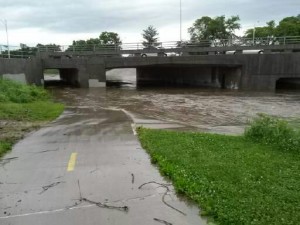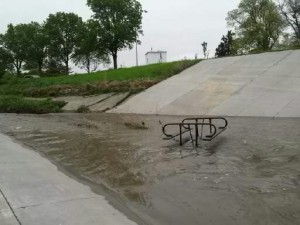We’ve all seen the images in the news. Cars swept away or under water in a flood. People stranded trying to get to higher ground or be rescued. This can happen to you on a bike, too. And not just in the historic flooding of this past May. It could have happened to you last Thursday or any time there’s an intense rush of water down Antelope Creek, or another of the the streams that some trails follow here in Lincoln and in other cities. These surges of water during a storm can rise quickly and an hour later the trail may be dry. I got caught in one of these last Thursday, even though I knew better. The water over the trail looked only about a foot deep where I could see it, an acceptable depth in my experience.

Not wanting to be late to a job, I proceeded with pant legs rolled up. Around the bend however, the story was quite different. If there had been water depth markings on the trail side embankment, it would have told me that the water was deeper than I wanted to go through and I would have turned around. As it was I continued until I got to higher ground, only to be faced with even deeper water ahead. Another cyclist I saw coming my way had water up to his waist, showing me that way was not a good option, and I didn’t want to return through what I had just come through. (Alternate title for this post: don’t get waisted) I opted for lifting my bike up over the embankment and continuing on the grass above until I found place to come out. I did have sure footing and the current wasn’t too fast. This was not the torrent of water that is funneled under street underpasses at times like these. Never try to pass through those. But now I have corroded cables and am hoping my bottom bracket escaped serious injury. So be aware. Looks can be deceiving and a trail you may have been down a hundred times can hold surprises in a sudden surge of water.

